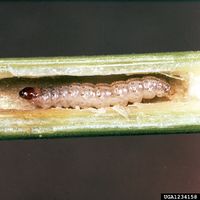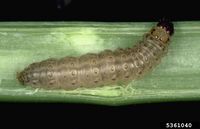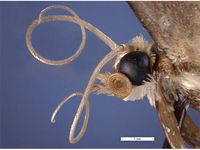Ostrinia nubilalis
| Literature database |
|---|
| 694 articles sorted by: |
| • year (descending) |
| • research topics |
| • countries/regions |
| • host plants |
| • list of natural enemies |
Ostrinia nubilalis (Hübner, 1796) - (European corn borer)
The moth is an important pest of maize in temperate parts of North America (first record in 1917) and Europe. The caterpillars feed on all parts of the maize plant except the roots. Older larvae usually bore into the whorl, stems and cobs, causing substantial damage. Other crops may also be attacked, like stems and fruits of hop, green pepper, potatoes, hemp, cotton, wheat, beans and grapevines, especially in the vicinity of corn. For control transgenic (Bt) maize, insecticides and cultural methods, like the removal of plant residues, are used. The life cycle from egg, through 5-6 larval stages to mature adult lasts around 2 months, depending on the temperature. There are 1-4 generations per year. It overwinters as mature larva in the maize stalks.
| Vernacular names | |
|---|---|
| • Deutsch: | Maiszünsler Hopfenzünsler Hirsezünsler |
| • English: | European corn borer |
| • Español: | taladro o barrenador Europeo del maíz piral del maíz |
| • Français: | pyrale du maïs perçeur européen du maïs |
The females have a wingspan of around 3-3½ cm and are usually yellowish to light brown with darker zig-zag lines across the forewings, while the males are slightly smaller and darker. In general, the wing pattern is rather variable. It has been suggested that strains of Ostrinia nubilalis not feeding on maize belong to the species Ostrinia scapulalis.
Synonyms:
Micractis nubilalis
Pyrausta nubilalis
For details see the respective page in BugwoodWiki.
- Other images of Ostrinia nubilalis (IPM images and Junta de Extremadura, Spain - click to enlarge)











